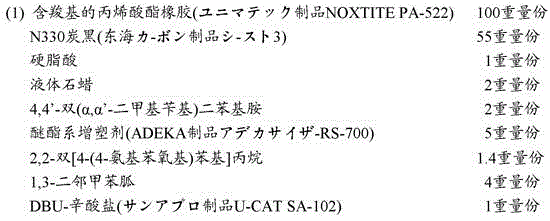rubber laminate
一种橡胶层、合体的技术,应用在橡胶层状产品、分层产品、机械设备等方向,能够解决不良率增加、氟橡胶硫化粘合性差、氟橡胶成本高等问题
- Summary
- Abstract
- Description
- Claims
- Application Information
AI Technical Summary
Problems solved by technology
Method used
Image
Examples
Embodiment 1
[0046]
[0047] The above-mentioned components were kneaded using an 8-inch roll, and then an unvulcanized sheet with a thickness of 3 to 4 mm was produced.
[0048]
[0049] The above-mentioned components were kneaded using an 8-inch roll, and then an unvulcanized sheet with a thickness of 3 to 4 mm was produced.
[0050] (3) Overlay the unvulcanized sheet formed by the above-mentioned carboxyl group-containing acrylate rubber composition with the unvulcanized sheet formed by the polyol crosslinkable fluororubber composition, at a temperature of 160° C., a surface pressure of 10 MPa, and a time of 30 minutes. Under these conditions, press molding is carried out, followed by open vulcanization (secondary vulcanization) at 175°C for 4 hours to form an acrylic rubber / fluororubber laminate.
[0051] A sample (15×100×5 mm) obtained by shearing the obtained rubber laminate was subjected to a peeling test (peeling speed: 50 mm / min) in accordance with JIS K6256, and measurement...
Embodiment 2
[0054] In Example 1, the amount of 1,3-di-o-tolylguanidine was changed to 6 parts by weight and used.
Embodiment 3
[0056] In Example 1, an equivalent amount (1 part by weight) of DBU-toluenesulfonate (U-CATSA506, manufactured by Sunapro) was used instead of DBU-octanoate.
PUM
| Property | Measurement | Unit |
|---|---|---|
| degree of polymerization | aaaaa | aaaaa |
Abstract
Description
Claims
Application Information
 Login to View More
Login to View More - R&D
- Intellectual Property
- Life Sciences
- Materials
- Tech Scout
- Unparalleled Data Quality
- Higher Quality Content
- 60% Fewer Hallucinations
Browse by: Latest US Patents, China's latest patents, Technical Efficacy Thesaurus, Application Domain, Technology Topic, Popular Technical Reports.
© 2025 PatSnap. All rights reserved.Legal|Privacy policy|Modern Slavery Act Transparency Statement|Sitemap|About US| Contact US: help@patsnap.com



